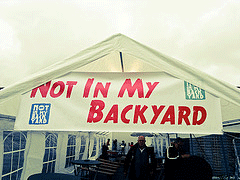
Photo by flickr user Marco Raaphorst, CC BY 2.0
NIMBY fights are a major obstacle to allowing lower-income households access to “communities of opportunity.” One of the things that is so frustrating about those fights is that they tend to be driven by misinformation and stubborn unfounded fears.
City Limits has a great piece up this week about the virulent opposition to supportive housing and homeless shelters—and whether the fears about them come to pass.
Called “After the Shouting, Do Shelters and Supportive Housing Harm Neighborhoods?,” the article examines the research and also visits some of the sites of bitterly contested facilities that still got built. Asking about actual negative affects, the reporter basically got crickets, even from former opponents.
We reported in 2012 about similar research in Massachusetts done on affordable housing developments that had faced serious, sustained, and detailed opposition. Similarly, the negative outcomes predicted, from environmental to traffic to school district problems almost never came to pass.
Now, it’s easier to track the effect of a specific development than, for example, the effect of an increase in neighborhood residents holding Housing Choice Vouchers (popularly still known as Section 8 vouchers). But happily the housing economists at the NYU Furman Center did the number crunching and controlling for other factors for us, and lo and behold, it turns out voucher holders do not increase crime in a neighborhood. At all. We’ve produced an easy-to-understand one-pager summarizing this research to show to anyone who is still trotting out this common falsehood.
Facts like these are unlikely to defuse a NIMBY fight entirely. But we hope that along with messaging and active incentives that they can be part of changing the conversation. How do you respond to NIMBY reactions? Please let us know by commenting below, or by emailing [email protected].




THERE IS A CRITICAL NEED FOR HOUSING FOR POOR AND LOW INCOME SINGLE ADULTS.